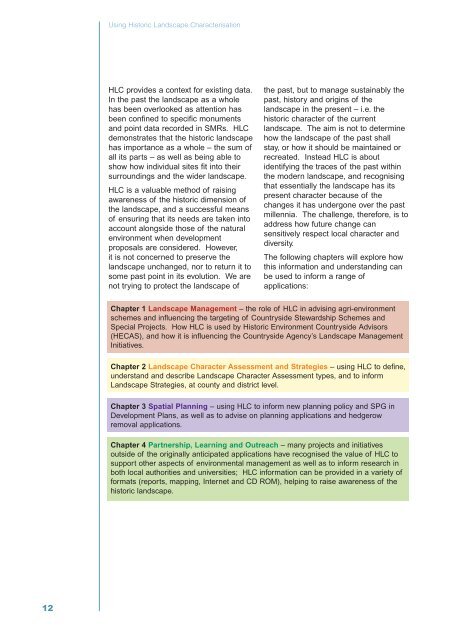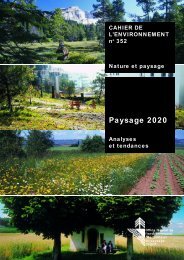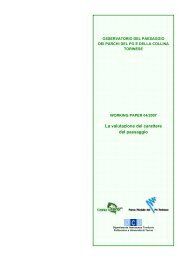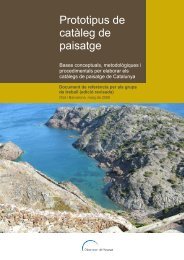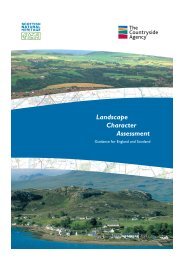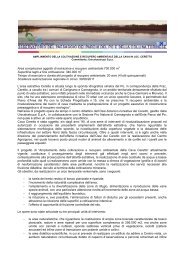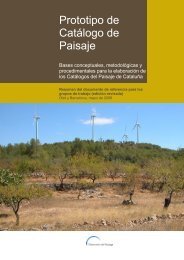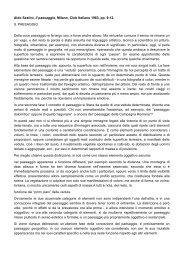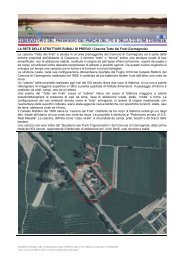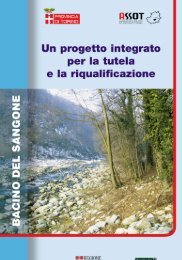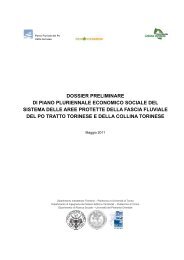Using Historic Landscape Characterisation
Using Historic Landscape Characterisation
Using Historic Landscape Characterisation
You also want an ePaper? Increase the reach of your titles
YUMPU automatically turns print PDFs into web optimized ePapers that Google loves.
<strong>Using</strong> <strong>Historic</strong> <strong>Landscape</strong> <strong>Characterisation</strong><br />
HLC provides a context for existing data.<br />
In the past the landscape as a whole<br />
has been overlooked as attention has<br />
been confined to specific monuments<br />
and point data recorded in SMRs. HLC<br />
demonstrates that the historic landscape<br />
has importance as a whole – the sum of<br />
all its parts – as well as being able to<br />
show how individual sites fit into their<br />
surroundings and the wider landscape.<br />
HLC is a valuable method of raising<br />
awareness of the historic dimension of<br />
the landscape, and a successful means<br />
of ensuring that its needs are taken into<br />
account alongside those of the natural<br />
environment when development<br />
proposals are considered. However,<br />
it is not concerned to preserve the<br />
landscape unchanged, nor to return it to<br />
some past point in its evolution. We are<br />
not trying to protect the landscape of<br />
the past, but to manage sustainably the<br />
past, history and origins of the<br />
landscape in the present – i.e. the<br />
historic character of the current<br />
landscape. The aim is not to determine<br />
how the landscape of the past shall<br />
stay, or how it should be maintained or<br />
recreated. Instead HLC is about<br />
identifying the traces of the past within<br />
the modern landscape, and recognising<br />
that essentially the landscape has its<br />
present character because of the<br />
changes it has undergone over the past<br />
millennia. The challenge, therefore, is to<br />
address how future change can<br />
sensitively respect local character and<br />
diversity.<br />
The following chapters will explore how<br />
this information and understanding can<br />
be used to inform a range of<br />
applications:<br />
Chapter 1 <strong>Landscape</strong> Management – the role of HLC in advising agri-environment<br />
schemes and influencing the targeting of Countryside Stewardship Schemes and<br />
Special Projects. How HLC is used by <strong>Historic</strong> Environment Countryside Advisors<br />
(HECAS), and how it is influencing the Countryside Agency’s <strong>Landscape</strong> Management<br />
Initiatives.<br />
Chapter 2 <strong>Landscape</strong> Character Assessment and Strategies – using HLC to define,<br />
understand and describe <strong>Landscape</strong> Character Assessment types, and to inform<br />
<strong>Landscape</strong> Strategies, at county and district level.<br />
Chapter 3 Spatial Planning – using HLC to inform new planning policy and SPG in<br />
Development Plans, as well as to advise on planning applications and hedgerow<br />
removal applications.<br />
Chapter 4 Partnership, Learning and Outreach – many projects and initiatives<br />
outside of the originally anticipated applications have recognised the value of HLC to<br />
support other aspects of environmental management as well as to inform research in<br />
both local authorities and universities; HLC information can be provided in a variety of<br />
formats (reports, mapping, Internet and CD ROM), helping to raise awareness of the<br />
historic landscape.<br />
12


